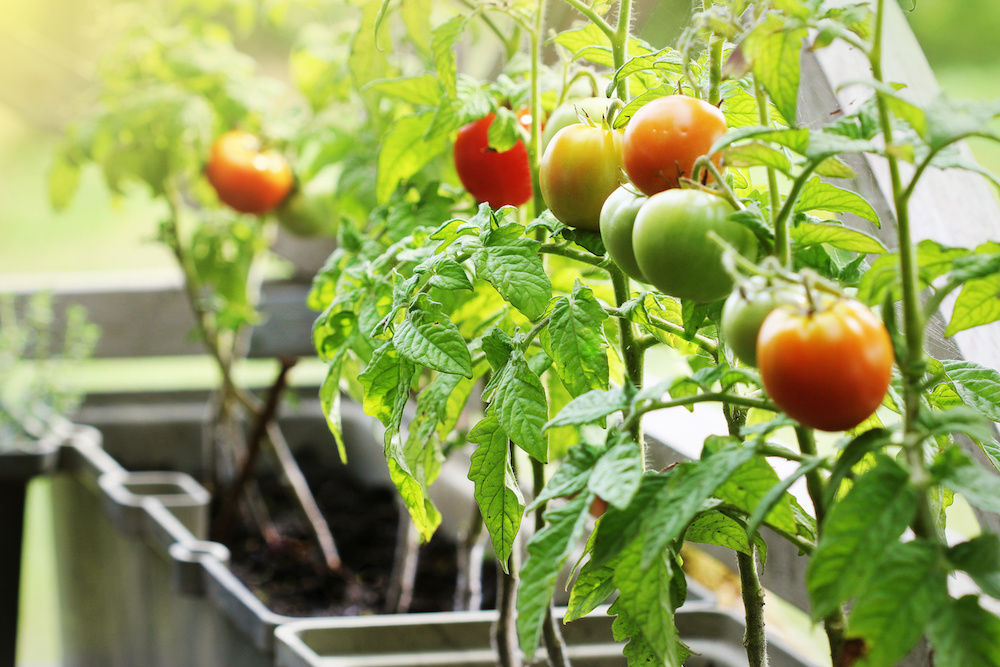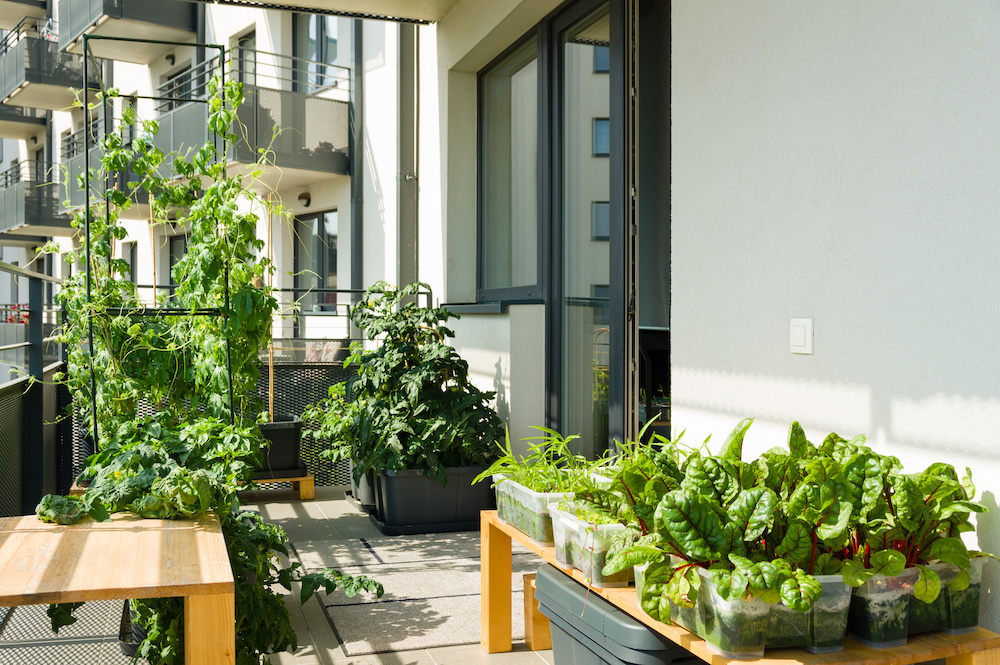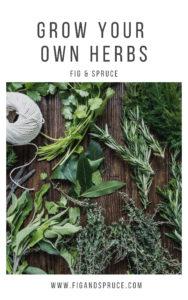Answering “What is organic container gardening?” could give you the ability to unlock a hidden household project.
If you’ve always wanted your garden but have been lacking space, these unique gardens could be the answer.
There is an assortment of edible fruits and vegetables and non-edible plants that you can grow in these space-saving setups.
Table of Contents
What Is Organic Container Gardening?
Container gardening is the unique process of maintaining plants in small, temporary, or permanent containers.
Most of the time, people opt for this gardening method because they don’t have enough space for a standard garden.
For example, for those living in condos with access to a small balcony, container gardening could be the only option.
Another exciting benefit that this task brings to the table is that you can do it relatively anywhere.
Homeowners can opt to have their container garden indoors or outdoors, depending on their plants’ needs.
It can also be a more affordable and less time-consuming method of producing various fruits and veggies.
When it comes to organic container gardening, you’ll be focusing primarily on organic means of soil nourishment.
For example, instead of using pesticides and herbicides, natural, organic compounds are used.
There are plenty of advantages to organic container gardening, including:
- Healthy edible plants
- Zero exposure to herbicides, pesticides, and other chemicals
- Gradual organic soil improvement
- Added biodiversity within your garden
The Benefits
Right off the bat, there are a significant number of benefits to container gardening, including:
- Straightforward
- Doesn’t require property space
- Inexpensive to start and maintain
- Require very tools
- Containers fit relatively anywhere
- Optimal control of growing conditions
- Easier to protect plants against inclement weather
You’ll also find that it’s one of the more ideal options for people who have owned unsuccessful gardens in the past.
With the straightforward nature of a container garden, relatively anyone, including kids, can create a productive garden.
Let’s explore some of the more prevalent benefits of starting a container garden.
Better Root Temperature
When planting inside containers, it’s easier to manage the temperature of your soil than with in-ground gardens.
You’ll find it’s simpler because you won’t be working against the elements and seasonal changes.
This point is crucial if you want to grow fruits and vegetables that are more susceptible to freezing.
When you have soil in a container, it’s always warm, especially indoors.
It’s one of the better options for planting tropical fruits and vegetables, especially with annual cycles.
However, it’s important to note that plants that love the cold weather could find container gardening less preferable.
As the soil is naturally warmer, the roots will be exposed to higher temperatures than recommended.
Just like in-ground gardens, you must choose your plant species accordingly.
Eliminating Weeds
There’s no doubt that one of the most challenging aspects of in-ground gardens is their maintenance.
It’s important to note that even container gardens require maintenance, but surely not as much.
For example, you won’t have to worry about weeds overtaking your garden if you don’t inspect it regularly.
Enhancing Creativity
One of the most beautiful parts of a garden is you get to see the gardener’s creativity poke through.
From arranging your plants to the ornamental species you choose, there’s no doubt it’s a creative process.
When you’re working with container gardens and limited space, you have to get creative.
Gardeners need to consider where they want to place their plants, the type of containers they need, and more.
You’ll find your planning will truly be at its peak if you have minimal space, such as a small balcony.
There are hundreds of inventive options to choose from when it comes to creating the perfect container garden.
The Disadvantages
As with any project involving growing living things, there are concerns to note as well.
Container gardening is simpler than you might have thought, but you should take some careful considerations.
Watering and Drainage
The most significant issue that first-time gardeners experience with their container gardens is watering and drainage.
Since the plants aren’t put into the ground, all excess water will seep through a small amount of soil.
Without drainage, the roots could easily drown, destroying your chances of a thriving, healthy garden.
Also, you’re solely responsible for the water your plants receive.
Unless you live in an area prone to rain, you’ll need to water your plants regularly to keep them alive.
Soil placed in container gardens is known to dry out quickly, so there is adequate maintenance required.
Increased Sun Exposure
Another concern to consider when it comes to your soil drying out is your plants’ exposure to the sun.
Of course, the sun is required for plants to produce nutrients to grow and yield fruits and veggies.
However, too much sun can significantly harm the amount of water kept within the soil.
In these instances, it’s often recommended to find the perfect placement for your containers beforehand.
Alternatively, you can add mulch to the soil, which can help block direct sun rays and maintain soil moisture.
As long as the root systems for your plants are protected, you’ll find that these gardens are user-friendly.
Fungus and Mold
On the other end of the spectrum, overwatering your plants can be easier with container gardens.
It’s important to remember you have a limited amount of soil within each container that you’ll be watering.
With in-ground gardens, on the other hand, water can seep into multiple feet of soil to prevent overwatering.
When you put too much moisture in the soil, it can cause a buildup of mold and fungus.
This issue is particularly prevalent with container gardens, as the soil has a naturally warmer temperature.
If you’re dealing with fungus and mold, you’ll have to replant your veggies to ensure they’re not affected.

What Can You Grow in a Container Garden?
There are multiple types of veggies that you can grow in container gardens with ease.
You’ll find the most popular recommendations are nightshades, like eggplant, tomatoes, and potatoes.
That said, you can traditionally work with any vegetable that doesn’t require a lot of space to grow.
Tomatoes
- USDA Growing Zone: Annual in all zones
- Sun Exposure: Full
- Soil: Good drainage, deep planting, moist conditions
Tomatoes are a phenomenal option for container gardens because they produce high yields with little effort.
They do prefer larger containers, which is something to consider when planning your garden.
Also, you’ll want to invest in stakes since the plants grow to incredible heights and require support for their heavy produce.
Tomatoes are best grown in warm weather, so container gardening is ideal with its warmer soil temperatures.
With that said, it’s best to put them out in the middle of spring or early summer, when the temperatures have evened out.
The most challenging part of growing tomatoes is if you opt to do so through seedlings.
When preparing the seedlings, they must be hardened off to acclimate to your local weather conditions.
Also, you need to maintain the seedlings by removing seed leaves as they grow.
Potatoes
- USDA Growing Zone: Three to 10B
- Sun Exposure: Full
- Soil: Loamy soil with good drainage
As another fantastic option for your garden, consider growing potatoes in containers.
You’ll find these veggies offer a new realm of flavors to your dishes with their bitter and earthy profiles.
When growing potatoes in container gardens, you’ll need plenty of soil and water as well as a lot of effort and maintenance.
However, they produce an excellent yield of veggies that you’ll surely put to good use.
These plants thrive in containers because the container material is a natural defense against blight.
Salad Greens
- USDA Growing Zone: Four through nine
- Sun Exposure: Partial
- Soil: Fertile and moist soil
There’s no doubt that salad greens are something you and your family use consistently.
Growing items like lettuce and kale are significantly simpler than you could imagine in containers.
With container gardening, you’ll be able to prevent weeds and pests more effectively compared to in-ground gardens.
The majority of salad greens can withstand summer but are often recommended as a spring plant.
With a container setup, you can easily extend your growing season by moving your plants to shaded areas.
Also, these varieties don’t require as much sunlight as other plants, making them highly versatile.
Cucumbers
- USDA Growing Zone: Four through 12
- Sun Exposure: Full or partial
- Soil: Fertilized, moist soil with good drainage
As another favorite for garden salads, cucumbers are a high-yield, fast-growing veggie for container gardens.
They’re fantastic for kids because they can track the progress of their plants weekly.
The most notable consideration for cucumbers is that they require a lot of water, making them best for plastic containers.
Cucumbers are known to love hotter temperatures, making them ideal for container gardening.
You also have versatility when choosing the type, such as bush or vining, depending on your space.
Ensure that you have plenty of stakes and/or trellis to accommodate the vine length if you opt for vining ones.
Final Thoughts
By answering, “What is organic container gardening?” you can finally begin your dream of creating your compact garden.
There are many great plants that you can grow with ease in small containers throughout your home.
Also, since it’s a user-friendly project, it’s something the whole family can get involved in.

